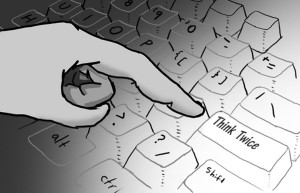Social media holds users accountable
The trial of Dharun Ravi, a Rutgers University student accused of spying on and harassing his gay roommate in 2010, is not just a story of cyberbullying and possible homophobia. It is also a story that teaches us that in the age of social media we will be held publicly accountable for our private actions.
On March 16, Ravi was convicted on 15 counts, the most severe of which was a bias intimidation charge. In September 2010, Ravi used a webcam to spy on his roommate, Tyler Clementi, while Clementi was on a date with another man. The bias intimidation charge deems Ravi’s behavior a hate crime driven by sexual orientation biases.
Clementi, who learned of Ravi’s actions after the fact, committed suicide shortly after the incident, on Sept. 22, 2010.
Even after exploring the facts presented in the media, it is difficult to affirm whether Ravi acted out of prejudice against Clementi.
The case paints a telling portrait of the consequences that come with a lack of awareness: The information that we put online immediately and irreversibly becomes part of an open, public space.
When Clementi asked Ravi to have the room to himself on Sept. 21, Ravi posted a tweet daring his friends to access his webcam and peek in on his roommate, just as he had done two days before.
In an interview with The Star-Ledger Thursday, Ravi said, “I knew my friends would think it was a joke because they know my sense of humor.”
In a “Letter to the Editor” in The New York Times, one man commented, “Mr. Ravi was an adult and unquestionably malicious and hateful in his actions.”
In an interview with Chris Cuomo, co-anchor of 20/20, however, Ravi denied such accusations, saying that he had assumed the tweet would only be read by his friends.
“We’re not really thinking about, you know, if someone else reads this, how are they going to feel,” Ravi said.
The trial and conviction reveals that people should think about the consequences of posting private information online, even if they’re just trying to get a laugh out of it.
Ravi’s Twitter account, though, was public and Clementi himself looked at it 38 times in the two days leading up to his suicide. Since the story first broke in 2010, people from all over the world have been exposed to these tweets.
Regardless of Ravi’s motives, there is a larger lesson to be learned from this.
The many social media websites, such as Twitter, that govern and drive our everyday lives are undeniably public places. By publishing our thoughts on such websites, we are converting private musings into public information.
As a result, we might need to answer for these private statements in the public realm. People who have never met us before — other students, co-workers, potential employees — might judge our characters based on what we post, even if we only mean it as a “joke.”
We live in an age in which the private and the public spheres are blurring together, and the consequences of which are not yet certain.
Sonali Chanchani is a freshman majoring in English.

